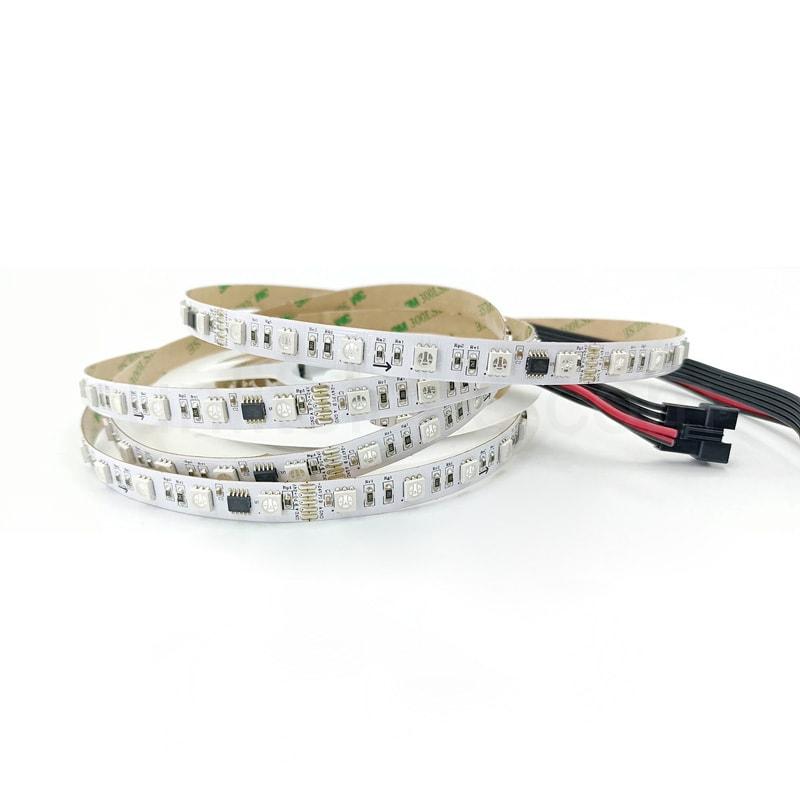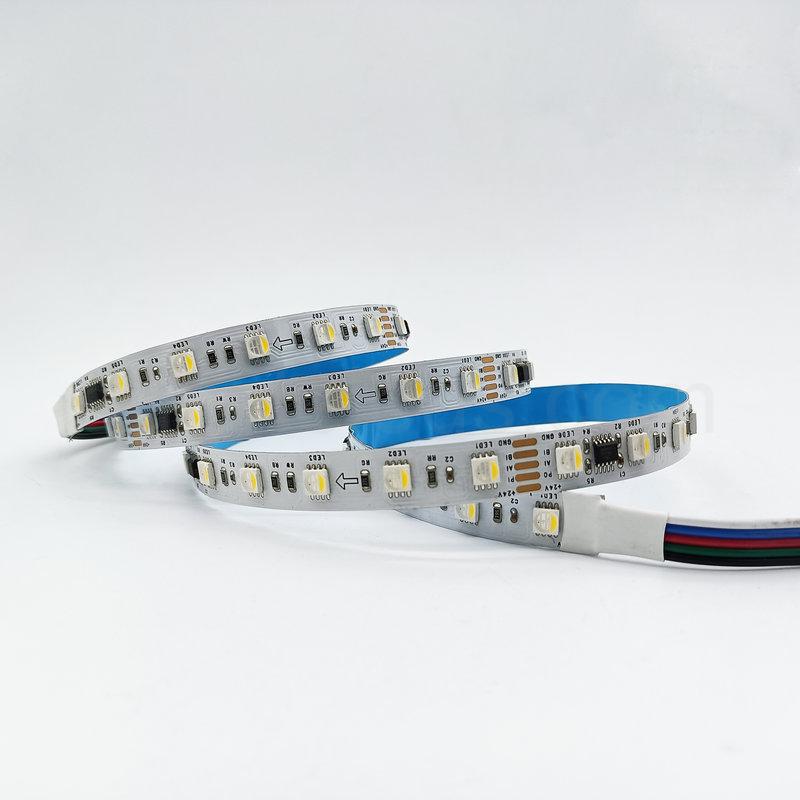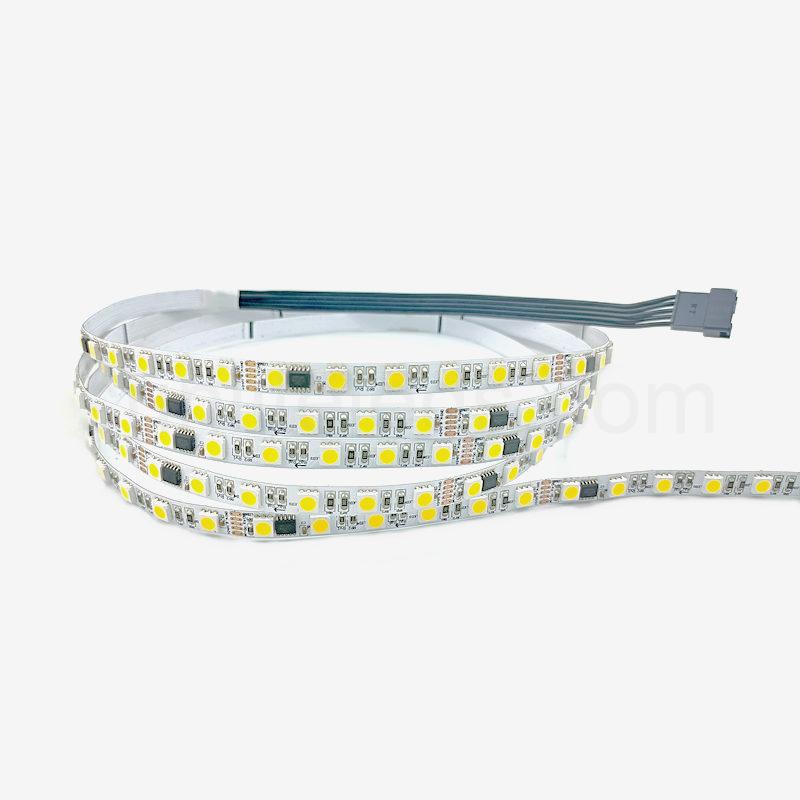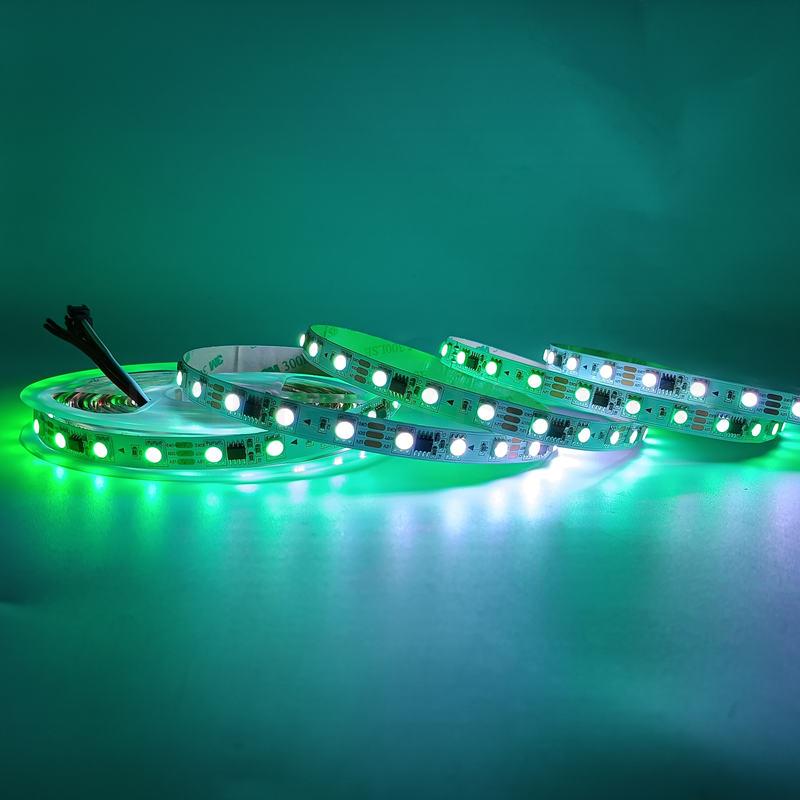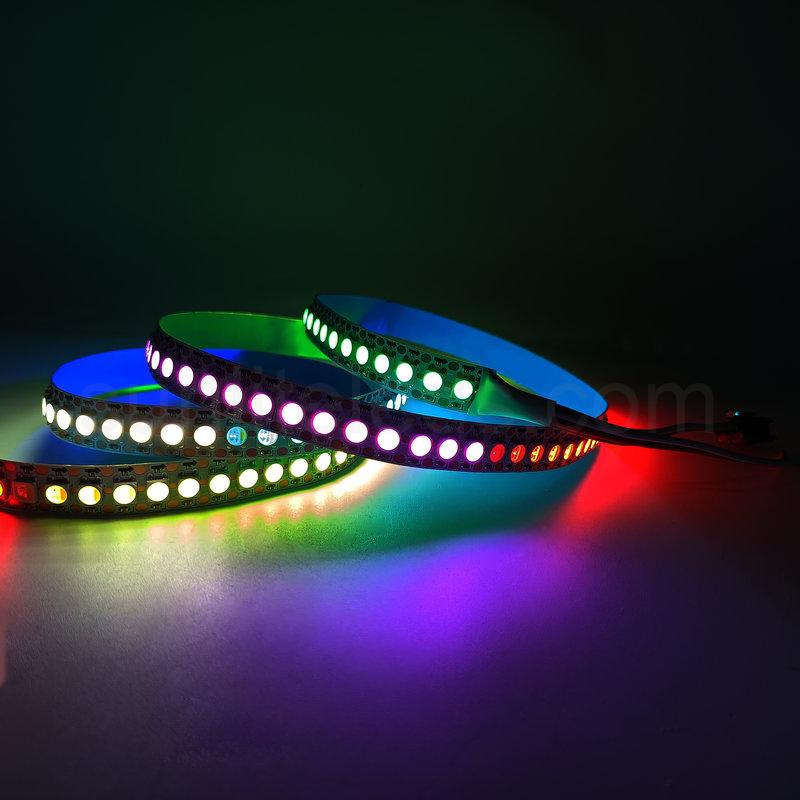Table of Contents
Introduction
According to different control protocols, digital addressable LED strips can be classified into two main categories: DMX LED strips and SPI LED strips. Both SPI and DMX protocols are widely used in the LED lighting industry and are considered industry standards. They both use serial communication protocol to transmit data in the form of digital signals to control LED lights.
However, there are significant differences between DMX and SPI LED strips in terms of control method, transmission rate, complexity, cost, etc.
In this article, we mainly discuss the differences between them, hope you make a wise choice when choosing between them.
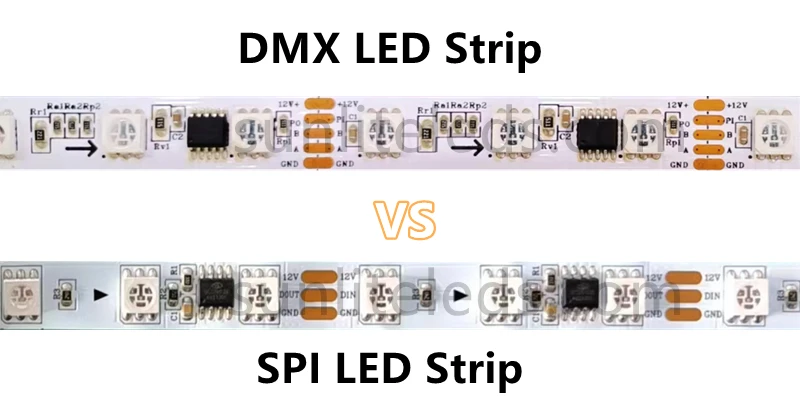
What is the difference between DMX & SPI LED strip?
SPI (Serial Peripheral Interface) and DMX (Digital Multiplex) are two different communication protocols used for controlling LED lighting. They both have some key differences in terms of control and installation.
Here we made a compare table to show the differences simply.
Table. DMX LED strip vs SPI LED strip
| Item | DMX LED Strips | SPI LED Strips |
|---|---|---|
| Control Method | Asynchronous serial | Synchronous serial |
| Number of Channels | Up to 512 per universe | Limited (up to 1024) |
| Data Transmission Speed | Slow (250 Kbps) | >800kbps, up to 2 Mbps |
| Pixel Transmission Distance | Longer (up to 500m) | Shorter (limited by signal) |
| Wiring Complexity | Complex | Simple |
| Communication Standard | Unified | Not unified |
| Break Continue Function | Yes | Depend on IC type |
| Cost | Higher | Lower |
| Application | stage, concert, club (large scale high end lighting) | retail showcase, home, DIY (small lighting decoration) |
From the above table, we can briefly see the difference between them. Next, we will introduce the difference between DMX and SPI LED strips in detail.
Control Method
DMX LED strip use asynchronous serial and SPI LED strip use synchronous serial.
Asynchronous serial communication protocols of DMX LED strip transmit data without a clock signal and use packets with start and stop bits.
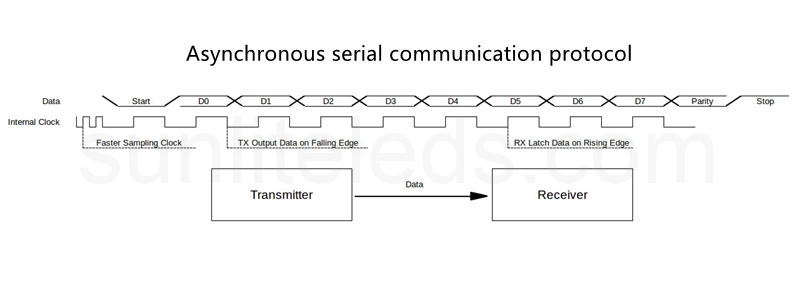
Synchronous serial communication protocols of SPI LED strips transmit data with a clock signal and are faster and more efficient.
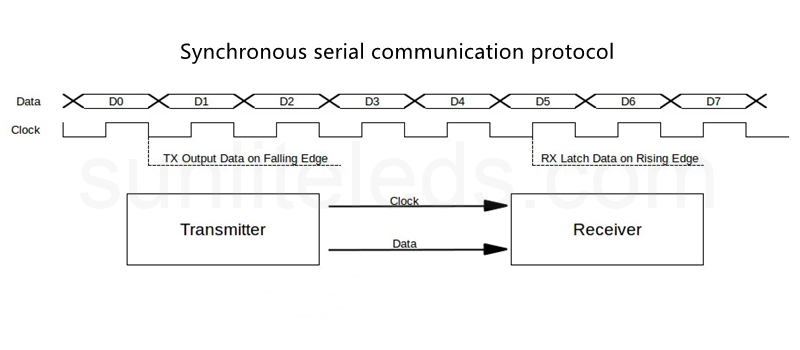
The main difference between the two types of serial communication protocols for LED strips is the way in which data is transmitted. DMX asynchronous serial communication is simpler and more flexible, but less efficient and slower than synchronous serial communication. SPI synchronous serial communication is more efficient but more complex, requiring specialized hardware and software for implementation.
Number of Channels
DMX supports up to 512 channels per universe, while SPI can support only a limited number of channels per data line (typically up to 1024 pixels). And DMX LED strips can control each RGB channel, while SPI LED strips may only have a single channel control for color and brightness. This means that DMX is better suited for controlling large-scale lighting projects, while SPI is better suited for smaller, more simple projects.
Data Transmission Speed
Data Transmission Speed: Data transmission speed refers to the rate at which data is transferred over the communication channel. SPI has a higher data transmission speed than DMX, usually with speeds of >800Kpbs and even up to 2 Mbps compared to DMX’s 250 Kbps.
Pixel Transmission Distance
Pixel transmission distance refers to the maximum distance that data can be transmitted over the communication cable. DMX has longer pixel transmission distance
capabilities, with distances of up to 500 meters, while SPI has a more limited cable length due to signal degradation over distance. This means that DMX is better suited for larger, more spread-out lighting installations, while SPI is better suited for smaller, more localized installations.
Wiring Complexity
All DMX LED strips have 5 wires, two wires for power, two wires for data, and a special wire for address setting. SPI LED strips usually be 3 wires or 4 wires. The WS2811, WS2812, SK6812, TM1814 LED strips have 3 wires, and WS2813, WS2815, WS2818, GS8208 LED strips have 4 wires. The DMX LED strip wiring is more complex. You need to connect with DMX Encoder to set the address first. (About how to address DMX LED strip, please watch this video guidance: DMX Address Setting)
After finishing the address setting, connect the strip to DMX controller to achieve dynamic lighting effects. Take K-1000C as an example, the connection method is as follows:

Note: No matter connect with the Address encoder or DMX controller, don’t connect the address wire. When connecting with other DMX strips, connect all 5 wires.
For SPI LED strips, whether it is 3-wire or 4-wire, the wiring is simple. Only need to connect V+, GND, and one data wire.
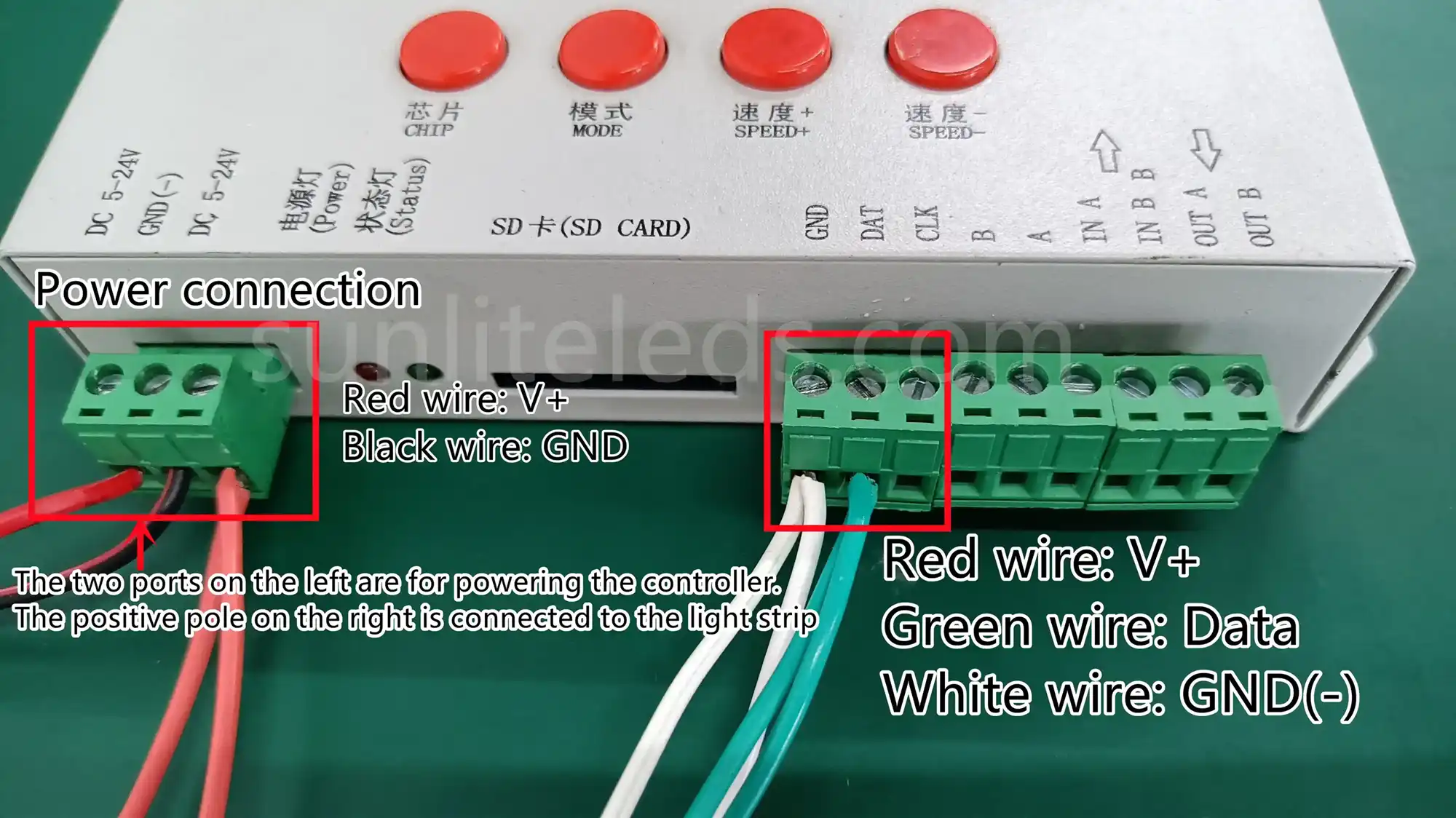
3 wires SPI LED strip connection
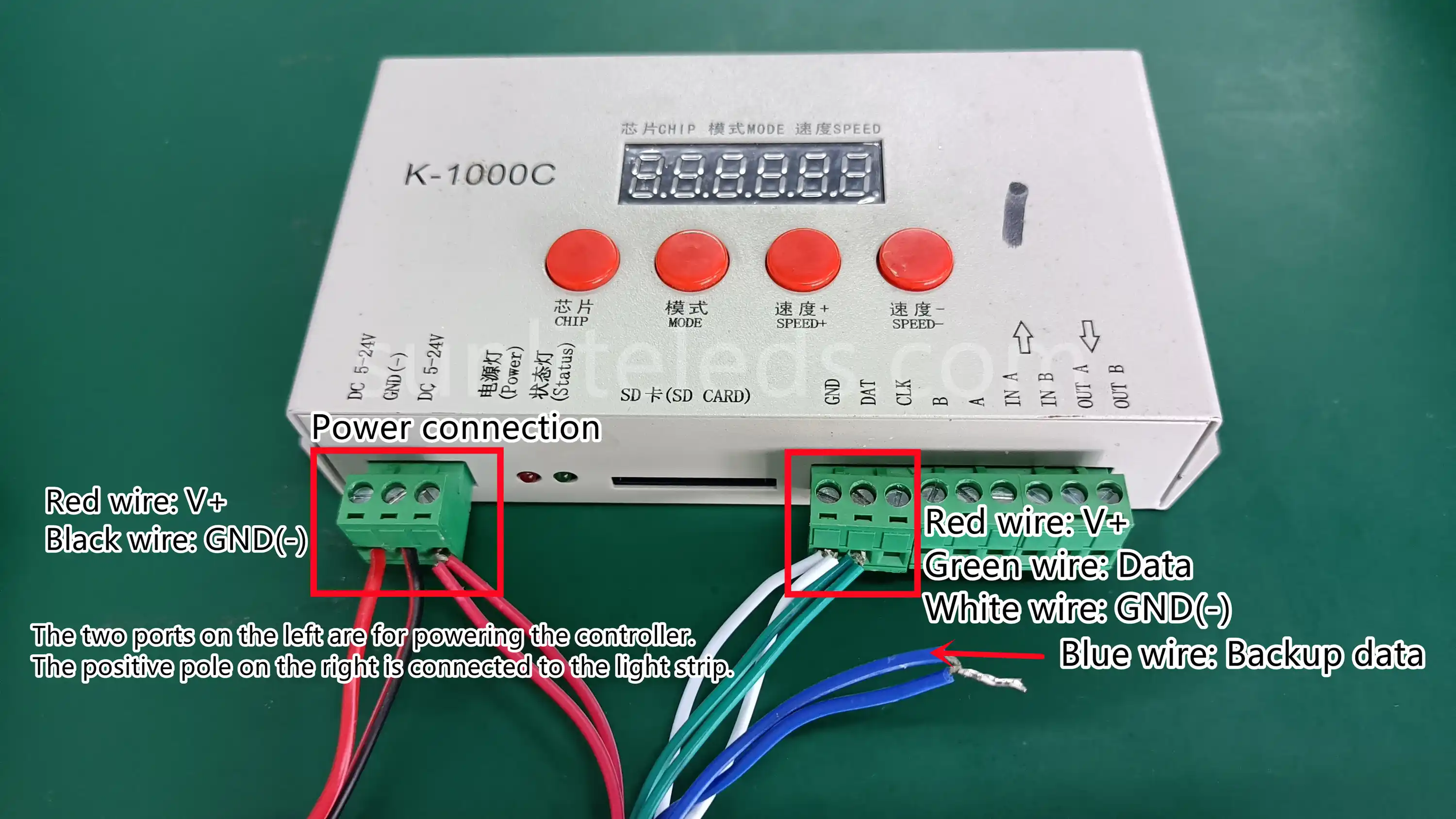
4 wires SPI LED strip connection
How to control connect and wire addressable LED strip? The video below displays how to connect and control DMX512 LED strip.
Communication Standard
All DMX LED strips with different ICs use the standard DMX512 communication protocol. However, the communication protocol of SPI LED strips is not uniform, and different ICs have different Synchronous serial protocols. So when processing an SPI LED strip lighting project, it’s better to use the strips with the same ICs.
Break Continue Function
The break-continue function (breakpoint resume) means that if one LED on the strip light is damaged or broken, the following LEDs on the strip can still work normally. All DMX LED strip lights have the break continue function. For SPI strip lights, the 4 wires strips such as WS2813, WS2815, and WS2818 LED strips lights support the break-continue function, but the 3 wires strips like WS2811, WS2812, and SK6812 LED strips don’t support this function.
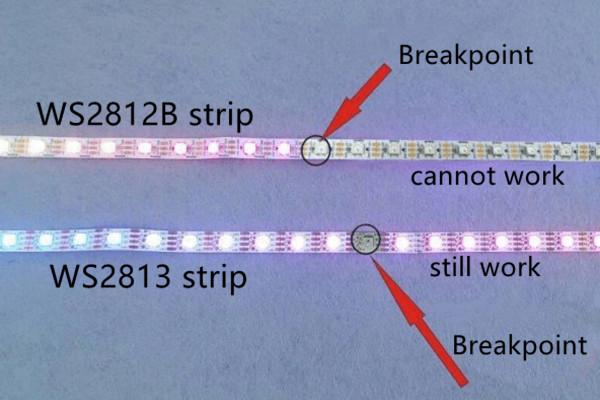
This video below let you know what is break continue or breakpoint resume.
Cost
The price of DMX LED strips is generally higher than SPI LED strips due to DMX LED strips are more complex than SPI LED strips and they are more suitable for professional lighting.
Application
DMX LED strips are often used in professional lighting applications such as stage lighting, concert and club lighting, architectural lighting, and large-scale installations. DMX allows for precise control over individual pixels, making it ideal for creating complex lighting effects and dynamic color changes.
While the SPI LED strips are more commonly used in DIY and hobbyist projects, as well as smaller-scale lighting installations such as backlighting and accent lighting. SPI is simpler to program and control than DMX, making it more accessible to beginners and hobbyists.
What is DMX LED strip?
DMX, short for Digital Multiplex, is a control protocol usually found in the entertainment industry, especially in stage and architectural lighting. DMX LED strips are versatile and can be controlled via a DMX controller or console.
Pros
- Professional-grade features: DMX LED strips offer a wide range of professional-grade features and capabilities, making them suitable for use in stage lighting, architectural lighting, and other high-end applications.
- Greater control options: DMX LED strips offer a variety of control options beyond just color and brightness, including strobing, fading, and pattern effects. This allows for more creative and dynamic lighting effects.
- Scalability: DMX LED strips can be scaled up to hundreds or thousands of pixels, making them ideal for large-scale projects and installations.
Cons
- Difficulty of learning: DMX requires some technical knowledge and expertise to operate, which may be a barrier for beginners or hobbyists.
- Cost: DMX LED strips are generally more expensive than other types of LED strips, reflecting their higher performance capabilities and professional-grade features.
- Higher power requirements: DMX LED strips can consume a lot of power, which may require additional power supplies or wiring to operate. This can add to the overall cost and complexity of the installation.
Here are some models of DMX LED Strip Light
What is SPI LED strip
Pros
- Easy to use: SPI LED strips are easy to set up and use, and can be controlled directly by a microcontroller or LED driver.
- Affordability: SPI LED strips are generally more affordable than DMX addressable LED strips, making them a popular choice for DIY and hobbyist projects.
- Low power consumption: SPI LED strips consume less power than other types of addressable LED strips, making them a more energy-efficient option.
Cons
- Limited professional-grade features: SPI LED strips may not offer the same level of professional-grade features and capabilities as DMX LED strips, which can limit their use in high-end lighting.
- Limited control options: SPI LED strips offer fewer control options than DMX LED strips, making it more difficult to create complex lighting effects or dynamic color changes.
- Limited scalability: SPI LED strips are typically limited to a few hundred pixels, making them less suitable for large-scale lighting installations.
Here are some SPI LED strip recommendations:
DMX or SPI, Which is better?
When choosing between DMX LED strips and SPI LED strips, it’s important to consider factors such as the complexity of the installation, the level of control needed, the scalability of the project, and the specific features and capabilities required. Ultimately, the choice will depend on the specific needs and requirements of the project, and both DMX LED strips and SPI LED strips offer a range of advantages and disadvantages that make them suitable for different types of applications.
Conclusion
In conclusion, DMX LED strips are typically more complex and expensive than SPI LED strips, but offer a wider range of professional-grade features and capabilities, making them suitable for use in stage lighting, architectural lighting, and other high-end applications. On the other hand, SPI LED strips are more affordable and easy to use than DMX LED strips, making them a popular choice for DIY and hobbyist projects, as well as smaller-scale lighting installations.
FAQs
What is the main difference between DMX and SPI LED strips?
DMX LED strips are typically used in professional settings and require a controller and decoder. SPI LED strips can be directly controlled by a microcontroller and offer individual pixel control.- Do I need professional assistance to install DMX or SPI LED strips?
Basic electrical and DIY skills are enough to install DMX or SPI LED strips, but for complex installations or high-end applications, professional assistance may be advisable. - Which is more cost-effective, DMX or SPI?
DMX LED strips are generally more expensive than SPI LED strips, mainly used for high-end lighting projects. SPI LED strips are more affordable and easier to use, making them a popular choice for DIY and hobbyist projects. - Which is better for dynamic lighting effects: DMX LED Strip or SPI LED Strip?
DMX LED strips are better for dynamic lighting effects due to their precise control and advanced lighting effects. - Is DMX or SPI better for home use?
For most home applications, SPI LED strips are usually sufficient due to their ease of installation and customization.

